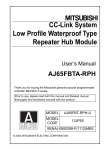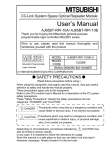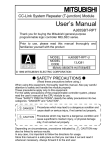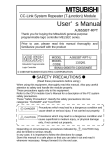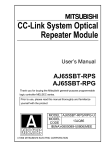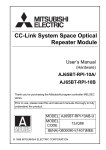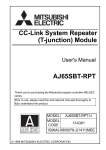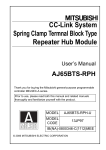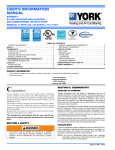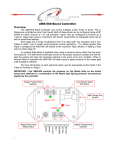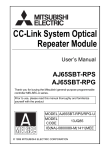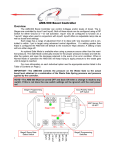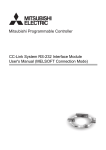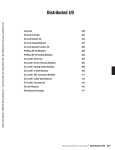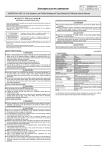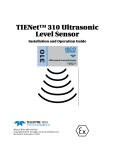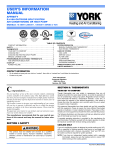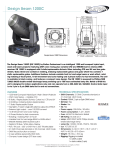Download CC-Link System Space Optical Repeater Module User`s Manual
Transcript
CC-Link System Space Optical Repeater Module User’s Manual AJ65BT-RPI-10A/ AJ65BT-RPI-10B Thank you for buying the Mitsubishi general-purpose programmable logic controller MELSEC series. Prior to use, please read this manual thoroughly and familiarize yourself with the product Mitsubishi Programmable Logic Controller MODEL AJ65BT-RPI-10AB-U MODEL 13JQ86 CODE IB(NA)-0800090-G(0708)MEE © 1999 MITSUBISHI ELECTRIC CORPORATION SAFETY PRECAUTIONS (Read these precautions before using.) When using this equipment, thoroughly read this manual. Also pay careful attention to safety and handle the module properly. These precautions apply only to this equipment. For the safety instructions of the PLC system, please read the user's manual for the CPU module to use. These "Safety Precautions" classify the safety precautions into two categories: "DANGER" and "CAUTION". DANGER Procedures which may lead to a dangerous condition and cause death or serious injury, if not carried out properly. CAUTION Procedures which may lead to a dangerous condition and cause superficial to medium injury, or physical damage only, if not carried out properly. Depending on circumstances, procedures indicated by CAUTION may also be linked to serious results. In any case, it is important to follow the directions for usage. Store this manual in a safe place so that you can take it out and read it whenever necessary. Always forward it to the end user. [DESIGN PRECATUIONS] DANGER Input/output could be switched on or off when a problem occurs in the repeater module. So build an external monitoring circuit that will monitor any input/output signals that could cause a serious accident. CAUTION Use each module in an environment as specified in the "general specification" in the CPU module User's Manual. Usage of the module outside the general specification range may cause electric shock, fire, malfunction, product damage or deterioration. Do not have control cables and communication cables bundled with or placed near by the main circuit and/or power cables. Wire those cables at least 100mm(3.94 inch) away from the main circuit and/or power cables. It may cause malfunction due to noise interference. [INSTALLATION PRECAUTIONS] CAUTION Do not directly touch the module's conductive parts. Doing so could cause malfunction or trouble in the module. Tighten the module securely using DIN rail or installation screws within the specified torque range. Loose terminal screws may cause falling, short circuit or erroneous operation. If the terminal screws are too tight, it may cause falling or short circuit due to damage of the screws. When using multiple sets of the AJ65BT-RPI-10A/10B in line, provide shields between the sets. Not doing so can cause a malfunction due to interference. When using multiple sets of the AJ65BT-RPI-10A/10B in parallel, place the A and B modules alternatively and keep a distance of at least 1m (3.28ft.). Not placing them alternately can cause a malfunction due to interference. [WIRING PRECAUTIONS] DANGER Be sure to shut off all phases of the external power supply used by the system before installation or wiring. Not doing so can cause the product to be damaged or malfunction. A-1 [WIRING PRECAUTIONS] CAUTION Always ground the FG terminal to the protective ground conductor. Otherwise there will be an electric shock or misoperation. Terminal screws which are not to be used must be tightened always. Otherwise there will be a danger of short circuit against the bare solderless terminals. Use applicable solderless terminals and tighten them with the specified torque. If any solderless spade terminal is used, it may be disconnected when the terminal screw comes loose, resulting in failure. Perform correct wiring for the module according to the product's rated voltage and terminal arrangement. Connecting to a power supply different from the rating or mis-wiring may cause fire and/or trouble. Fix terminal screws securely with the specified torque. Loose terminal screws may cause short circuit or malfunction. If the terminal screws are too tight, it may cause falling, short circuit or erroneous operation due to damage of the screws or module. Make sure foreign objects do not get inside the module, such as dirt and wire chips. It may cause fire, trouble or malfunction. Be sure to fix wires or cables that are connected to the module in place, either by running them through a duct or by using clamps. If the cables are not fixed in one of these ways, dispersion, movement, or careless pulling of the cables may cause damage to the module or cables, or malfunction due to cable contact faults. Do not install the control lines together with the communication cables, or bring them close to each other. Failure to do so may cause malfunctions due to noise. When disconnecting a communication or power supply cable from the module, do not pull on the cable itself. Before disconnecting the cable from the terminal block, loosen off the screws of the terminal block. If you pull the cable connected to the module, the module or cable can be damaged or misoperation can occur due to cable connection fault. [STARTUP AND MAINTENANCE PRECAUTIONS] DANGER Do not touch terminals when the power is on. It may cause an electric shock or malfunction. CAUTION For use in any environment where optical axis misalignment or the like is expected due to lens surface contamination, vibration, impact or the like, carry out periodic maintenance/inspection and improve the environment. Not doing so can cause a malfunction. Never try to disassemble or modify module. It may cause trouble, malfunction, injury or fire. A-2 [STARTUP AND MAINTENANCE PRECAUTIONS] CAUTION The module case is made of resin; do not drop it or subject it to strong shock. Module damage may result. Be sure to shut off all phases of the external power supply used by the system before cleaning or retightening the terminal screws. Not doing so can cause the module to fail or malfunction. Be sure to shut off all phases of the external power supply used by the system before mounting or dismounting the module to or from the panel. Not doing so can cause the module to fail or malfunction. Do not install/remove the terminal block more then 50 times after the first use of the product. (IEC 61131-2 compliant) Always make sure to touch the grounded metal to discharge the electricity charged in the body, etc., before touching the module. Failure to do so may cause a failure or malfunctions of the module. [DISPOSAL PRECAUTIONS] CAUTION When disposing of this product, treat it as industrial waste. A-3 REVISIONS The manual number is given on the bottom left of the back cover. Print Date Nov.,1999 Feb.,2001 June,2003 Manual Number Revision IB (NA)-0800090-A First edition IB (NA)-0800090-B Partial correction Change specified torque range of Display window mounting screw from 32 to 5.8N/cm on Section 4.2.1(1) IB (NA)-0800090-C Partial correction SAFETY PRECAUTIONS, About the Manuals, Chapter 1, Section 1.3, 2.2, 3.1, 3.2, 4.2.1, 4.6 Jul.,2005 Dec.,2006 IB (NA)-0800090-D Addition Conformation to the EMC Directive and Low Voltage Instruction Partial correction SAFETY PRECAUTIONS IB (NA)-0800090-E Partial correction SAFETY PRECAUTIONS, About the Manuals, Section 1.3, 2.2, 3.1, 3.2, 3.4, 4.2.1 Jun.,2007 IB (NA)-0800090-F Aug.,2007 IB (NA)-0800090-G Partial correction Section 4.3 Partial correction Section 4.3, Contact address (Back cover) This manual confers no industrial property rights or any rights of any other kind, nor dose it confer any patent licenses. Mitsubishi Electric Corporation cannot be held responsible for any problems involving industrial property rights which may occur as a result of using the contents noted in this manual. © 1999 MITSUBISHI ELECTRIC CORPORATION A-4 CONTENTS 1. OVERVIEW .................................................................................................. 1 1.1 Features ................................................................................................. 1 1.2 Packaged parts....................................................................................... 2 1.3 Abbreviated names, generic names and terms ....................................... 3 2. SYSTEM CONFIGURATION ........................................................................ 4 2.1 Total configuration .................................................................................. 4 2.2 Cautions on system configuration ........................................................... 5 3. SPECIFICATIONS...................................................................................... 10 3.1 General specifications........................................................................... 10 3.2 Performance specifications ................................................................... 11 3.3 Specifications of connection cables ...................................................... 12 3.4 Max. transmission distance................................................................... 13 3.5 List of I/O Signals from/to the Master Module ....................................... 13 4. PROCEDURE UP TO START OF DATA LINK ........................................... 14 4.1 Procedure up to start of data link .......................................................... 14 4.2 Mounting and installation ...................................................................... 14 4.2.1 Cautions on handling .................................................................... 14 4.2.2 Installation environment ................................................................ 18 4.3 Names and settings of parts ................................................................. 18 4.4 Setting of switches ................................................................................ 20 4.5 Connection of module through CC-Link dedicated cable....................... 21 4.6 Optical axis adjustment......................................................................... 22 4.6.1 Precautions for optical axis adjustment......................................... 22 4.6.2 Optical axis adjustment method .................................................... 22 4.6.3 Adjustment procedures for interference light................................. 23 4.7 Check for state of connection (line test) ................................................ 25 5. ABOUT THE MONITOR FUNCTION .......................................................... 26 6. TROUBLESHOOTING................................................................................ 26 7. EXTERNAL DIMENSIONS DIAGRAM........................................................ 27 A-5 About the Manuals The following manuals are related to this product. Referring to this list, please request the necessary manuals. Related manuals Manual Name AJ61BT11, A1SJ61BT11 CC-Link System Master/Local Module User's Manual (Detail version) AJ61QBT11, A1SJ61QBT11 CC-Link System Master/Local Module User's Manual (Detail version) QJ61BT11N CC-Link System Master/Local Module User's Manual (Detail version) CC-Link System Repeater (T-junction) Module User’s Manual AJ65SBT-RPT CC-Link System Optical Repeater Module User’s Manual AJ65SBT-RPS/RPG CC-Link System Low Profile Waterproof Type Repeater Hub Module User’s Manual AJ65FBTA-RPH CC-Link System Spring Clamp Terminal Block Type Repeater Hub Module User’s Manual AJ65BTS-RPH Manual Number (Model Code) IB(NA)-66721 (13J872) IB(NA)-66722 (13J873) SH(NA)-080394E (13JR64) IB(NA)-0800078 (13JQ81) IB(NA)-0800089 (13JQ85) IB(NA)-0800288 (13JP55) IB(NA)-0800346 (13JP97) Conformation to the EMC Directive and Low Voltage Instruction When complying with EMC Directives and Low-Voltage Directives by assembling a Mitsubishi PLC compatible with EMC Directive and Low-Voltage Directives into the user product, refer to Chapter 3 "EMC Directives and LowVoltage Directives" in the User's Manual (Hardware) for the CPU module being used. The CE logo is printed on the rating plate on the main body of the PLC that conforms to the EMC directive and low voltage instruction. To conform this product to the EMC Directive and Low Voltage Directive, refer to the Section of "CC-Link Modules" in Chapter 3 "EMC Directive and Low Voltage Directive" of the User's Manual (Hardware) of the CPU module used. A-6 1. OVERVIEW This User's Manual describes the specifications, part names, settings and others of the AJ65BT-RPI-10A/10B type CC-Link system space optical repeater module (hereafter abbreviated to the AJ65BT-RPI-10A/10B) used in a CC-Link system. 1.1 Features The AJ65BT-RPI-10A/10B is a module used to expand the CC-Link system. By using the AJ65BT-RPI-10A and AJ65BT-RPI-10B in combination, infrared space transmission, increased transmission distance and T-junction wiring can be achieved in a CC-Link system (at the transmission speed of 2.5Mbps, 625kbps or 156kbps only). Also, the optical axis adjustment can be made easily because the light receiving status of the module can be transmitted to the master station. (1) Infrared space transmission Using these modules enables infrared space transmission of 0 to 100m (0 to 327.87ft.). This makes a CC-Link system usable in places where cabling is difficult. Local station Master station Repeater Repeater Remote station Movable Space transmission CC-Link dedicated cable Termination resistor (required) [Places where cabling is difficult] • Place where a movable range is wide • Place where the number of movable times is large and cables may be broken due to fatigue • Place where you want to minimize the number of movable parts, e.g. cable bearers, for dust proof purpose (such as a clean room) (2) Increased transmission distance Using these modules increases the transmission distance of a CC-Link system. Also, using multiple sets of these modules allows the transmission distance to be increased by up to two stages. Master station Increased up to 3.8km!! *1 Remote I/O station Repeater Remote station *2 *2 1st stage 2nd stage Space transmission Termination resistor (required) CC-Link dedicated cable *1 Max. transmission distance at the transmission speed setting of 156kbps. *2 Though omitted here, another remote station may be connected between repeaters. 1 (3) T-junction wiring enabled in CC-Link system T-junction wiring can be performed by arrangement of these modules between the modules of a CC-Link system. Master station Repeater Remote I/O station Intelligent device station Remote device station Repeater T-junction wiring enabled!! Remote I/O station Space transmission CC-Link dedicated cable Termination resistor (required) (4) Communication status of the module can be monitored The light receiving status of the module can be monitored (imported to the master station) by setting the station numbers to these modules and also making the remote I/O station-equivalent parameter setting in the master station. Also, the imported receiving status of the mating module can be indicated by the LEDs of the own module using the sequence program of the master station, ensuring ease of fine adjustment of the optical axes. POINT Station number and parameter settings are not needed when these modules are used as repeaters only, i.e. the light receiving status is not monitored (monitor function is not used). 1.2 Packaged parts After unpacking, make sure that those parts listed below are packaged. (1) AJ65BT-RPI-10A Part name AJ65BT-RPI-10A module Terminating resistances 110 Terminating resistances 130 1/2W (Brown, Brown, Brown) 1/2W (Brown, Orange, Brown) Quantity 1 1 1 (1) AJ65BT-RPI-10B Part name AJ65BT-RPI-10B module Terminating resistances 110 Terminating resistances 130 1/2W (Brown, Brown, Brown) 1/2W (Brown, Orange, Brown) 2 Quantity 1 1 1 1.3 Abbreviated names, generic names and terms Abbreviated names, generic names and terms Description Abbreviated names, generic names and terms AJ65BT-RPI-10A/10B AJ65SBT-RPT AJ65SBT-RPS/RPG AJ65FBTA-RPH AJ65BTS-RPH A module B module Segment Master station Local station Remote I/O station Remote device station Remote station Intelligent device station Repeater Ready master station Master local module Master module Local module Remote module Intelligent device module Description Abbreviation of AJ65BT-RPI-10A/AJ65BT-RPI-10B type CC-Link system space optical repeater module Abbreviation of AJ65SBT-RPT type CC-Link system repeater (Tjunction) module. Abbreviation of AJ65SBT-RPS/AJ65SBT-RPG type CC-Kink system optical repeater module. Abbreviation of AJ65FBTA-RPH type CC-Link system low profile waterproof type repeater hub module. Abbreviation of AJ65BTS-RPH type CC-Link system spring clamp terminal block type repeater hub module. Abbreviation of AJ65BT-RPI-10A type CC-Link system space optical repeater module Abbreviation of AJ65BT-RPI-10B type CC-Link system space optical repeater module System between terminating resistances connected to each other through cross-over cables.The conventional CC-Link system can be said to be configured with one segment (See Section 2.1.). Station to control the data link system. One station is required for each system. Station which has a sequencer CPU and can communicate with the master station and the other local stations. Remote station processing only information in unit of bit. (AJ65BTB1-16D, AJ65SBTB1-16D, AJ65SBTB1-8 , etc.) Remote station processing only information in unit of bit and in unit of word.(AJ65BT-64AD, AJ65BT-64DAV, AJ65BT-64DAI, etc.) Generic name of remote I/O station and remote device station. Controlled by the master station. Station allowing transient transmission such as AJ65BT-R2.(Including local stations) Module for expanding the CC-Link system by connecting the segments to each other. Backup station which inherits data link control when the master station comes off parallel due to error. Generic name of QJ61BT11N, QJ61BT11, AJ61BT11, A1SJ61BT11, AJ61QBT11 and A1SJ61QBT11. Generic name of QJ61BT11N, QJ61BT11, AJ61BT11, A1SJ61BT11, AJ61QBT11 and A1SJ61QBT11 when these are used as the master station. Generic name of QJ61BT11N, QJ61BT11, AJ61BT11, A1SJ61BT11, AJ61QBT11 and A1SJ61QBT11 when these are used as the local station. Generic name of AJ65BTB1-16D, AJ65SBTB1-16D, AJ65BT-64AD, AJ65BT-64DAV, AJ65BT-64DAI and A852GOT. Module allowing transient transmission such as AJ65BT-R2. 3 2. SYSTEM CONFIGURATION 2.1 Total configuration The total configuration employed when the AJ65BT-RPI-10A/10B module is used is as shown below. [Segment] Master station*2 Intelligent Repeater *1 Repeater *1 Remote I/O (the A or B module) device station (the A or B module) station [Segment (1st stage)] Remote I/O station Remote device station Repeater *1 (the B or A module) Intelligent Remote device station device station [Segment (1st stage)] Local station Remote I/O station Repeater *1 (the A or B module) Repeater *1 (the B or A module) [Segment (2nd stage)] *3 Remote I/O station Remote I/O station Space transmission CC-Link dedicated cable Repeater *1 (the B or A module) Termination resistor (required) *1 The A and B modules must be used in pairs. *2 The transmission speed of each segment must be matched with that of the master station (2.5Mbps, 625kbps, 156kbps). *3 Up to two stages of segments may be used. (1) What is a repeater? This is the module for expanding the CC-Link system by connecting the segments to each other. (2) What is a segment? In the CC-Link system where repeaters are used, the equipment included between terminating resistances connected to each other through crossover cables is generally called the segment. 4 2.2 Cautions on system configuration (1) About the combination of modules used Always use the AJ65BT-RPI-10A/10B in such a configuration that the lens surfaces of the A and B modules are opposed. There are no restrictions on the sequence of connections. (Either the A or B module may be placed on the master station side.) (2) Conditions of usable master module When the AJ61BT11, A1SJ61BT11, AJ61QBT11 and A1SJ61QBT11 modules are used, those of the functional version B or later must be employed. Use the master module bearing the version 9707 B or later in the DATE column of the name plate as shown in the figure below. When the QJ61BT11N and QJ61BT11 module is used, any module can be used irrespective of the version. MITSUBISHI CPU UNIT MODEL A2USHCPU-S1 PROGRAMMABLE CONTROLLER DATE 9707 MAX 30kSTEP DATE 9707 B B MITSUBISHI ELECTRIC CORPORATION JAPAN BD992D013H01 MITSUBISHI ELECTRIC Year and month of manufacture Function version BD992D008H38 Year and month of manufacture Function version (3) Max. number of modules connected to configure CC-Link system Up to 64 modules of repeaters can be connected in one segment. In the CC-Link system where repeaters are used, also the number of remote stations capable of being controlled by one master station is the same as in the other systems. For details, refer to the User's Manual of the applicable master module. (When the monitor function is used in these modules, they must be counted not as repeaters but as remote I/O stations.) (4) Max. number of stages connected to configure segment These modules may be used to communicate with a remote station up to two segments away from the segment of the master station. Master station Transmission speed: 156kbps setting Segment Max. 1200m (3934.43ft.) Space transmission Max. 100m (327.87ft.) Repeaters Remote station Segment (1st stage) Max. 1200m (3934.43ft.) Max. transmission distance Space transmission Max. 100m (327.87ft.) 3.8km (12459.02ft.) Segment (2nd stage) Max. 1200m (3934.43ft.) 5 (5) Instructions for using different models of repeaters in combination Note that when combining the repeaters of different models, there are the following restrictions on the number of connectable repeaters and the number of connected stages. Max. number of repeaters Combination pattern AJ65BTS -RPH AJ65FBT A-RPH AJ65SBT -RPH AJ65SBT -RPS AJ65SBT -RPG AJ65BT -RPI -10A/10B 1 — 2 — — — — 1 2 — — — 1 — — 2(1set) — — 1 — — — 2(1 set) — — 1 — 2(1 set) — — — 1 — — 2(1 set) — 1 — — — — 2(1 set) — 1 — — — 2(1 set) 4) — — 2 4(2 set) — — 5) — — 2 — 2(1 set) — 6) — — 2 — — 2(1 set) 7) — — — 2(1 set) 2(1 set) — — — — 2(1 set) — 2(1 set) — — — — 2(1 set) 2(1 set) 1 1 — — — — 1) 2) 3) 8) 9) Max. number of stages 3 2 4 3 2 POINT • For the CC-Link system, up to 2 repeater types can be used in combination. Using 3 models or more is not allowed. • When repeaters are connected in the same segment by link wiring, up to 64 modules can be connected. For details, refer to the user's manual of the master module used. Ex.) A CC-Link system with combination pattern 7) is built Master station Segment AJ65FBTA-RPH Up to 64 modules can be connected in a segment. AJ65BT-RPI Segment 1st stage Segment AJ65BT-RPI 2nd stage Remote station Segment 3rd stage For combination pattern 6), 4 (2 sets) or more AJ65BT-RPIs are not connectable. 6 (a) Combination pattern 1) (c) Combination pattern 3) Master station Master station Segment Segment AJ65BTS-RPH or AJ65FBTA-RPH One module AJ65BTS-RPH or AJ65FBTA-RPH One module Segment 1st stage IN Segment 1st stage AJ65BT-RPI Two modules (one set) OUT AJ65SBT-RPT Up to two modules Segment 2nd stage IN OUT Remote station Segment 2nd stage Segment 3rd stage Remote station (b) Combination pattern 2) (d) Combination pattern 4) Master station Master station Segment Segment AJ65BTS-RPH or AJ65FBTA-RPH One module IN OUT AJ65SBT-RPT Up to two modules Segment 1st stage Segment 1st stage IN AJ65SBT-RPS or AJ65SBT-RPG Two modules (one set) OUT Segment 2nd stage Segment 2nd stage AJ65SBT-RPS Four modules (two sets) or Two modules (one set) Remote station Segment 3rd stage Segment 4th stage Remote station 7 (e) Combination pattern 1) (g) Combination pattern 3) Master station Master station Segment Segment IN OUT AJ65SBT-RPT Up to two modules AJ65SBT-RPS Two modules (one set) Segment 1st stage IN OUT Segment 1st stage Segment 2nd stage AJ65SBT-RPG Two modules (one set) AJ65SBT-RPG Two modules (one set) Segment 3rd stage Segment 2nd stage Remote station Remote station (f) Combination pattern 2) (h) Combination pattern 4) Master station Master station Segment Segment IN AJ65SBT-RPS or AJ65SBT-RPG Two modules (one set) OUT AJ65SBT-RPT Up to two modules Segment 1st stage IN OUT Segment 1st stage Segment 2nd stage AJ65BT-RPI Two modules (one set) AJ65BT-RPI Two modules (one set) Segment 2st stage Segment 3rd stage Remote station Remote station 8 (h) Combination pattern 1) Master station Segment AJ65BTS-RPH One module Segment 1st stage AJ65FBTA-RPH One module Segment 2nd stage Remote station 9 3. SPECIFICATIONS 3.1 General specifications This section provides specifications of the AJ65BT-RPI-10A/10B module used. Item Operating ambient temperature Storage ambient temperature Operating ambient humidity Storage ambient humidity Vibration resistance Specifications 0 to 50 -25 to 75 10 to 90%RH, non-condensing 10 to 90%RH, non-condensing Conforming to JIS B 3502, IEC 61131-2 Under intermittent vibration Under continuous vibration Frequency Acceleration 10 to 57Hz ——— 57 to 150Hz 98m/s 10 to 57Hz ——— 57 to 150Hz 2 2 Amplitude Sweep count 0.75mm (0.03in.) ——— 0.35mm (0.01in.) ——— 10 times each in X, Y, Z directions (for 80 min.) 49m/s 2 Conforming to JIS B 3502, IEC 61131-2 (490 m/s , 10 times in each of 3 Shock resistance directions X, Y, Z) Operating ambience No corrosive gases Ambient 10000 lx max. (no exposure to direct sunlight) illumination*3 Cooling method Self-cooling method Operating altitude*4 2000m (6562ft.) max. Installation location Indoor Overvoltage II max. category *1 Pollution level *2 2 max. *1 : This indicates the section of the power supply to which the equipment is assumed to be connected between the public electrical power distribution network and the machinery within premises. Category II applies to equipment for which electrical power is supplied from fixed facilities. The surge voltage withstand level for up to the rated voltage of 300 V is 2500 V. *2 : This index indicates the degree to which conductive material is generated in terms of the environment in which the equipment is used. Pollution level 2 is when only non-conductive pollution occurs. A temporary conductivity caused by condensing must be expected occasionally. *3 : The reference values of ambient illumination (in JIS Z 9110) are indicated below. • Illumination needed for fine visual work in factories : 3000 to 1500 lx • Illumination needed for work in offices : 2000 to 750 lx *4 : Do not use or store the PLC in the environment where the pressure is higher than the atmospheric pressure at sea level. Otherwise, malfunction may result. To use the PLC in a high-pressure environment, contact your local Mitsubishi representative. 10 3.2 Performance specifications The following table lists the performance specifications of the AJ65BT-RPI10A/10B. Item Specifications Power Voltage supply Current Noise immunity Common Dielectric withstand specifications voltage Insulation resistance 20.4 to 26.4VDC 137mA (at TYP. 24VDC) Simulator noise of 500Vp-p, obtained by a noise simulator of 1 s noise width and 25 to 60Hz noise frequency 500VAC for 1 minute between all DC external terminals and ground 10M or higher, measured with a 500VDC insulation resistance tester Weight Transmission speed Max. number of segments connected CC-Link communication specifications Max. transmission distance of each segment 0.5kg Can be selected from among 156kbps, 625kbps and 2.5Mbps. AJ65BT-RPI only (Refer to Section 2.2(4)) 2stages Combination of AJ65BT-RPI and AJ65SBTRPT (Refer to Section 2.2(5)) 3stages Combination of AJ65BT-RPI and one of AJ65SBT-RPS, AJ65SBT-RPG, AJ65FBTARPH, Or AJ65BTS-RPH.(Refer to Section 2.2 (5)) 2stages Depending on the transmission speed. (Refer to the user's manual of the master module used.) Max. number of connected modules 64 (Refer to Section 2.2(3) for the conditions of the number of modules connected.) Number of stations occupied When using monitor function : 1station When not using monitor function : 0station (Refer to Chapter 5 for details of the monitor function.) Optical transmission distance Optical Orientation angle communication specifications Modulation frequency 0 to 100m (0 to 327.87ft.) Optical transmission distance of 0 to 50m (0 to 163.94ft.) : Full angle 2O Optical transmission distance of 50 to 100m (163.94 to 327.87ft.) : Full angle 1O A module to B module: 36 B module to A module: 44 Modulation system FSK 11 3MHz 2.5MHz 3.3 Specifications of connection cables Use the CC-Link dedicated cable for the CC-Link system. If a cable other than the CC-Link dedicated cable is used, the performance of the CC-Link system cannot be guaranteed. For the specifications of the CC-Link dedicated cables or any other inquires, visit the following site: CC-Link Partner Association website: http://www.cc-link.org/ REMARK For details, refer to the CC-Link cable wiring manual issued by the CC-Link Partner Association. 12 3.4 Max. transmission distance Master station Transmission speed: 156kbps setting Segment Max. 1200m (3934.43ft.) Space transmission Max. 100m (327.87ft.) Repeaters Remote station Conditions Segment (1st stage) Max. 1200m (3934.43ft.) Max. transmission distance Space transmission Max. 100m (327.87ft.) 3.8km (12459.02ft.) Segment (2nd stage) Max. 1200m (3934.43ft.) Description The maximum transmission distance in each segment is the same as that in normal CC-Link system (system configured with one segment only). The maximum transmission distance in each segment varies according to the transmission speed. For details, refer to the User's Manual of the applicable master module. (The length of the cables between repeater stations is treated in the same manner as in the remote I/O station.) Transmission speed Max. number of stages connected to configure segment When one connection stage is added, the maximum transmission distance is added by an amount equivalent to one segment. 3.5 List of I/O Signals from/to the Master Module The following tables provide the I/O signals transferred from/to the master module when the monitor function is used in the AJ65BT-RPI-10A/10B. Refer to Chapter 5 for details of the monitor function. Refer to Section 4.3 for the definitions of the operation indicator LEDs used to explain the signals. (1) Input signals (AJ65BT-RPI-10A/10B to master module) Input Signal RXn0 RXn1 RXn2 RXn3 RXn4 to RX(n+1)F Signal Name RC status R1 status R2 status R3 status Description ON indicates that the module is ready to receive data. ON indicates that the allowance of the light receiving level is 1.5 times or higher *. ON indicates that the allowance of the light receiving level is 2.0 times or higher *. ON indicates that the allowance of the light receiving level is 2.5 times or higher *. —— Must not be used. *Value based on the RC status signal (1 time). (2) Output signals (Master module to AJ65BT-RPI-10A/10B) Output Signal Ryn0 to RYnF RY(n+1)0 RY(n+1)1 RY(n+1)2 RY(n+1)3 RY(n+1)4 to RX(n+1)F Signal Name Description —— Must not be used. SC ON S1 ON S2 ON S2 ON Lights up the "SC" operation indicator LED.* Lights up the "S1" operation indicator LED.* Lights up the "S2" operation indicator LED.* Lights up the "S3" operation indicator LED.* —— Must not be used. * The RC, R1, R2 and R3 status signals of the mating module can be indicated by the operation indicator LEDs of the own module using the sequence program of the master station, ensuring ease of optical axis adjustment. 13 4. PROCEDURE UP TO START OF DATA LINK 4.1 Procedure up to start of data link The procedure ranging from the installation of the AJ65BT-RPI-10A/10B module to the start of data link is described below. Start Install the AJ65BT-RPI-10A/10B module. Refer to Section 4.2. Set the switches of the module. Refer to Section 4.4. Connect the modules using CC-Link dedicated cables. Refer to Section 4.5. Make AJ65BT-RPI-10A/10B(A module B module) adjustment of the optical axes. Refer to Section 4.6. Check for the connection conditions of the modules (line test). Refer to Section 4.7. Start the system. Refer to the User's Manual of the applicable master module. Completion POINT The procedure described here is for the AJ65BT-RPI-10A/10B module only. In order for you to understand the procedure of the entire CC-Link system, refer to the User's Manual of the applicable master module. 4.2 Mounting and installation 4.2.1 Cautions on handling Cautions on handling the AJ65BT-RPI-10A/10B module are described below. DANGER Perform installation and wiring after disconnecting the power supply at all phases externally. If the power is not disconnected at all phases an electric shock or product damage may result. Do not touch terminals when the power is on. It may cause an electric shock or malfunction. 14 CAUTION Do not have control cables and communication cables bundled with or placed near by the main circuit and/or power cables. It may cause malfunction due to noise interference. Wire those cables at least 100mm(3.94 inch) away from the main circuit and/or power cables. Do not directly touch the module's conductive parts. Doing so could cause malfunction or trouble in the module. Tighten the module securely using DIN rail or installation screws within the specified torque range. Loose terminal screws may cause falling, short circuit or erroneous operation. If the terminal screws are too tight, it may cause falling or short circuit due to damage of the screws. When using multiple sets of the AJ65BT-RPI-10A/10B in line, provide shields between the sets. Not doing so can cause a malfunction due to interference. When using multiple sets of the AJ65BT-RPI-10A/10B in parallel, place the A and B modules alternatively and keep a distance of at least 1m (3.28ft.). Not placing them alternately can cause a malfunction due to interference. Fix terminal screws securely with the specified torque. Loose terminal screws may cause short circuit or erroneous operation. If the terminal screws are too tight, it may cause falling, short circuit or erroneous operation due to damage of the screws or module. Always ground the FG terminal to the protective ground conductor. Otherwise there will be an electric shock or misoperation. Terminal screws which are not to be used must be tightened always. Otherwise there will be a danger of short circuit against the bare solderless terminals. Use applicable solderless terminals and tighten them with the specified torque. If any solderless spade terminal is used, it may be disconnected when the terminal screw comes loose, resulting in failure. Perform correct wiring for the module according to the product's rated voltage and terminal arrangement. Connecting to a power supply different from the rating or mis-wiring may cause fire and/or trouble. Make sure foreign objects do not get inside the module, such as dirt and wire chips. It may cause fire, trouble or malfunction. Be sure to fix the wires or cables by ducts or clamps when connecting them to the module. If the cables are not fixed in one of these ways, dispersion, movement, or careless pulling of the cables may cause damage to the module or cables, or malfunction due to cable contact faults. Do not install the control lines together with the communication cables, or bring them close to each other. Failure to do so may cause malfunctions due to noise. When disconnecting a communication or power supply cable from the module, do not pull on the cable itself. Before disconnecting the cable from the terminal block, loosen off the screws of the terminal block. If you pull the cable connected to the module, the module or cable can be damaged or misoperation can occur due to cable connection fault. 15 CAUTION For use in any environment where optical axis misalignment or the like is expected due to lens surface contamination, vibration, impact or the like, carry out periodic maintenance/inspection and improve the environment. Not doing so can cause a malfunction. Never try to disassemble or modify the module. It may cause trouble, malfunction, injury or fire. The module case is made of resin; do not drop it or subject it to strong shock. A module damage may result. Perform cleaning the module or re-tightening of terminal screws after making sure to turn off the external power supply. If you do not switch off the external power supply, it will cause trouble or malfunction of the module. Be sure to shut off all phases of the external power supply used by the system before mounting or dismounting the module to or from the panel. If you do not switch off the external power supply, it will cause trouble or malfunction of the module. Do not install/remove the terminal block more than 50 times after the first use of the product. (IEC 61131-2 compliant) Always make sure to touch the grounded metal to discharge the electricity charged in the body, etc., before touching the module. Failure to do so may cause a failure or malfunctions of the module. When disposing of this product, treat it as industrial waste. (1) Tighten the module fixing screws and terminal block screws to those torques specified below. Do not over-tighten these screws. The screws and module case may be damaged. Screw location Specified torque range (N/cm) Module mounting screw (M6 thread with finished circular flat washer) 120 Display window mounting screw (M2.6 thread) 5.8 Terminal block screw (M3 thread) 59 to 88 Terminal block mounting screw (M3.5 thread) 68 to 98 (2) When mounting the AJ65BT-RPI-10A/10B, it has no specific mounting orientation as a module alone. However, it should be mounted with its top face placed in the same orientation as that of the mating module with which optical communication is made. When these modules are mounted in opposite orientations, they must be mounted more than 1m(3.28ft.) away from each other. [Top faces set in the same orientation] Top face [Top faces set in the opposite orientations] Top face Top face 0 to 100m (0 to 327.87ft.) More than 1m (3.28ft.)away Top face (3) When using multiple sets of the AJ65BT-RPI-10A/10B in line, provide shields between the sets.Not doing so can cause a malfunction due to interference. Shield needed 16 (4) When using multiple sets of the AJ65BT-RPI-10A/10B in parallel, place the A and B modules alternatively and keep a distance of at least 1m (3.28ft.). Not placing them alternately can cause a malfunction due to interference. Referring to the figure showing the relation between the optical communication distance and the distance from the other system, adjust the optical axis to remove the influence of interference light. (Refer to Section 4.6.3.) A module 1m (3.28ft.) at least B module Install modules alternately and keep a distance of at least 1m (3.28ft.) . Distance from other system (m) B module A module 8 Adjustment for interference light not required 4 Adjustment for interference light required (Worst-case value *2) Adjustment for interference light required (Normal value *1) 1 Not used 0 0 10 50 100 Optical communication distance (m) *1 A value obtained when the optical axis of each system is adjusted to nearly the center of the area in which the operation indicator LED, R3 turns on. *2 A value obtained when the optical axis of the system is slanted toward the other system. 17 4.2.2 Installation environment For installation environment, refer to Section 3.1 (General Specifications). 4.3 Names and settings of parts This section explains the part names, LED indication definitions, and switch and control setting methods of the AJ65BT-RPI-10A/10B. 5) 10) 8) 8) 8) 23 4 01 56 9 B RATE 78 01 23 4 9 56 ST NO.X10 78 01 23 4 9 56 ST NO.X1 78 Expanded view B RATE 78 56 4 9 01 2) 10) 23 4 8) 9) 8) Expanded view 8) 1) 23 56 ST NO.X1 78 01 4 9 23 4) 01 3) 9 56 ST NO.X10 78 7) 6) No. Name 1) Operation indicator LEDs Application Check for the module condition by observing the state of lighting of the LED. LED Application Name ON : Indicates that power is ON. PW OFF: Indicates that power is OFF. ON : Indicates normal communication when the monitor function is used. LRUN OFF: Indicates that a communication error occurred when the monitor function is used or that the monitor function is not used. ON : Indicates that a communication error occurred when the monitor function is used or that the monitor function is not used. LERR OFF: Indicates normal communication when the monitor function is used. ON : Indicates a communication error. ERR OFF: Indicates a normal status. ON : Indicates that data is being sent to the connection cable side. SD1 OFF: Indicates that data is not sent to the connection cable side. ON : Indicates that data is being sent to the light output side. SD2 OFF: Indicates that data is not sent to the light output side. ON : Indicates that data is being received from the connection cable side. RD1 OFF: Indicates that data is not received from the connection cable side. ON : Indicates that data is being received from the light input side. RD2 OFF: Indicates that data is not received from the light input side. 18 No. 1) 2) 3) 4) 5) 6) 7) 8) 9) 10) Name Application Check for the module condition by observing the state of lighting of the LED. LED Application Name ON : Indicates that RY(n+1)0 is ON. SC OFF: Indicates that RY(n+1)0 is OFF. Lit only when the monitor ON : Indicates that RY(n+1)1 is ON. S1 function is used. OFF: Indicates that RY(n+1)1 is OFF. Refer to Chapter 5 for ON: Indicates that RY(n+1)2 is ON. details of the monitor S2 OFF: Indicates that RY(n+1)2 is OFF. function. ON: Indicates that RY(n+1)3 is ON. S3 OFF: Indicates that RY(n+1)3 is OFF. Operation ON : Indicates that the own module is enabled for light receiving. RC indicator OFF: Indicates that the own module is disabled for light receiving. LEDs ON : Indicates that the light receiving level allowance of the own module is 1.5 times or more. R1 OFF: Indicates that the light receiving level allowance of the own module is less than 1.5 times (based on RC). ON : Indicates that the light receiving level allowance of the own module is 2.0 times or more. R2 OFF: Indicates that the light receiving level allowance of the own module is less than 2.0 times (based on RC). ON : Indicates that the light receiving level allowance of the own module is 2.5 times or more. R3 OFF: Indicates that the light receiving level allowance of the own module is less than 2.5 times (based on RC). Used to set the transmission speed of the module. (Factory setting: 0) Transmission 0 : 156kbps speed setting 1 : 625kbps switch 2 : 2.5Mbps 3 to 9 : Must not be set. Station Used to set the station number of the module. number setting Also used to set whether the monitor function is used or not. (Factory setting: 0) switch (Tens) 00 : Monitor function is not used Station 01 to 64 : Station number when monitor function is used number setting 65 to 99 : Must not be set. switch (Units) Lens surfaces Used to make optical communication. Terminal block Used to connect the power supply cable and CC-Link dedicated cables. Used to set whether the built-in termination resistor (110 ) of the module is Termination used or not. (Factory setting: OFF) resistor ON : Used switch OFF: Not used Module Used to fix the module to the mounting bracket. mounting Mounting bracket screws Mounting Used to mount the module. bracket Display window Used to fix the display window to the module. mounting screws The display window is removed when switch setting is to be made. POINT The settings of the transmission speed setting switch and station number setting switches are made valid when the module power is switched from OFF to ON. If any switch setting has been changed with the module power ON, perform the above operation again. 19 4.4 Setting of switches The setting of the switches on the AJ65BT-RPI-10A/10B module is described below. (1) Transmission speed setting switch This switch is used to set the transmission speed of the AJ65BT-RPI10A/10B module. For detail of the setting, see Section 4.3. POINT • Set to the same state of setting as set in the master station. • The states of setting of the transmission speed setting switch obtained when the module power supply is set from OFF to ON or the reset switch is set to OFF become effective. When the states of setting are changed with the module power supply turned ON, perform the above operations again. (2) Station number setting switches The station number setting switches are used to set the station number of the AJ65BT-RPI-10A/10B. It is also used to set whether the monitor function is used or not. For full information on the setting, refer to Section 4.3. For full information on the monitor function, refer to Chapter 5. POINT The setting of the station number setting switches is made valid when the module power is switched from OFF to ON. If the setting has been changed with the module power ON, perform the above operation again. (3) Termination resistor switch The termination resistor switch is used to set whether the built-in termination resistor (110 ) of the AJ65BT-RPI-10A/10B is used (ON) or not (OFF). Set this switch to the ON (used) position when the AJ65BT-RPI10A/10B is located on either side of the segment and the accessory termination resistor is not used. POINT • In either of the following cases, do not use the built-in termination resistor (110 ) of the AJ65BT-RPI-10A/10B but use the accessory termination resistor. 1) When the 130 termination resistor is needed. 2) There is a possibility of removing the AJ65BT-RPI-10A/10B without affecting the other stations for maintenance or other purpose. When the built-in termination resistor is used, removing the terminal block from the module makes the termination resistor disconnected, disabling the other stations from making normal communication. • Do not use the built-in termination resistor and accessory termination resistor of the AJ65BT-RPI-10A/10B at the same time. Doing so makes the module doubly provided with the termination resistors, disabling normal communication. 20 4.5 Connection of module through CC-Link dedicated cable The method of connecting the AJ65BT-RPI-10A/10B module to the CC-Link system through the CC-Link dedicated cable is shown below. Termination resistances Master module AJ65BT-RPI-10A/10B Remote module DA DA DA DB DB DB DG DG DG SLD FG CC-Link dedicated cable SLD CC-Link dedicated cable FG Termination resistances SLD FG Lens surfaces Space transmission Termination resistances Lens surfaces DA DA DB DB DG DG SLD FG CC-Link dedicated cable AJ65BT-RPI-10A/10B Termination resistances SLD FG Local module Important In each segment, ensure to use the same type of CC-Link dedicated cables. If different types of cables are used, normal data transmission will not be assured. POINT • Ensure to connect the terminating resistances to both end modules of each segment. In addition, connect them between DA and DB (DA1-DB1 and DA2-DB2 for AJ65BT-RPI-10A/10B). (The terminating resistances are furnished with the module.) • The terminating resistances vary according to the type of cables in use. For detail, refer to the User's Manual of the applicable master module. • Connect the shield cable of the CC-Link dedicated cable to "SLD" of each module, and ground both ends of the cable through "FG" to a class-D (class 3) ground. SLD and FG are wired to each other inside the module. 21 4.6 Optical axis adjustment 4.6.1 Precautions for optical axis adjustment For the optical axis adjustment, pay attention to the following. (1) Adjust the optical axis of each system to the center of the light receiving level area as much as possible. (Refer to Section 4.6.2.) When multiple sets of the AJ65BT-RPI-10A/10B are used in parallel, turn off the other system(s) before starting the optical axis adjustment. (2) When the AJ65BT-RPI-10A/10B is installed to a movable body, check that the adjusted position in the light receiving level is not lowered during movement. (3) When multiple sets of the AJ65BT-RPI-10A/10B are used in parallel, check that the individual system is not affected by interference light from the other system. (Refer to Section 4.6.3.) 4.6.2 Optical axis adjustment method The optical axis is adjusted in the following steps. (1) Place the modules face-to-face and align the module axes approximately. (2) While observing the operation indicator LEDs of the module (A module), change the angle of the other module (B module) in vertical or horizontal directions to obtain a proper angular range in which the operation indicator LED, R3 turns on. Note that, if A module is moved at this time, the reference axis cannot be fixed and proper adjustment will be difficult. (3) Check the operation indicator LEDs on both modules. Confirming the LEDs on one module only may not adjust the other optical axis. (a) Vertical angle adjustment R C 1 A Module B Module 2 3 Fix the module and check the operation indicator LED, R3 turns on. Adjust the angle. (b) Horizontal angle adjustment R C A Module B Module 1 2 3 Fix the module and check the operation indicator LED, R3 turns on. 22 Adjust the angle. 4.6.3 Adjustment procedures for interference light The following is the adjustment procedures for interference light emitted from the other system. (1) Influence of interference light between module A1 and A2 (a) Turn on the module A1 and A2 only and turn off the module B1 and B2. (b) Check for influence of interference light emitted from A1 to A2 1) When the operation indicator LED, R1 of A2 is off: No influence of interference light is identified. 2) When the operation indicator LED, R1 of A2 is on: The influence of interference light is identified. Readjust the optical axis of module A1 by making it away from the system (2). (c) Check for influence of interference light emitted from A2 to A1 1) When the operation indicator LED, R1 of A1 is off: No influence of interference light is identified. 2) When the operation indicator LED, R1 of A1 is on: Influence of interference light is identified. Readjust the optical axis of module A2 by making it away from the system (1). R C Check that R1 is off. Module A1 Module B1 1 System (1) 2 3 Interference (OFF) light (ON) R C System (2) Module B2 (OFF) 23 1 Module A2 (ON) 2 3 Check that R1 is off. (2) Influence of interference light between module B1 and B2 (a) Turn on the module B1 and B2 only and turn off the module A1 and A2. (b) Check for influence of interference light emitted from B1 to B2 1) When the operation indicator LED, R1 of B2 is off: No influence of interference light is identified. 2) When the operation indicator LED, R1 of B2 is on: The influence of interference light is identified. Readjust the optical axis of module B1 by making it away from the system (2). (c) Check for influence of interference light emitted from B2 to B1 1) When the operation indicator LED, R1 of B1 is off: No influence of interference light is identified. 2) When the operation indicator LED, R1 of B1 is on: The influence of interference light is identified. Readjust the optical axis of module B2 by making it away from the system (1). R Module B1 Module A1 1 Check that 2 R1 is off. System (1) (OFF) (ON) Interference light R C Check that R1 is off. 1 System 2 3 C (2) Module B2 (ON) Module A2 (OFF) 24 3 4.7 Check for state of connection (line test) After connecting all modules including the AJ65BT-RPI-10A/10B, check whether the CC-Link system can establish proper data links or not. To perform the line test of the AJ65BT-RPI-10A/10B module, use the line test 2 of the master module. For the line test 2 of the master module, refer to the User's Manual of the applicable master module. Perform the test following the steps shown below. Start Set the test switch to OFF (normal operation). After checking the input power supply voltage, turn on the power supply. Perform the line test 2 of the master module. In this test, use any one station connected to the downstream side of the AJ65BT-RPI-10A/10B (side where the master station does not exist). YES NO NO YES Does "ERR." go off? NO YES Do "RD1" and "SD2" light up? NO YES Do "RD2" and "SD1" light up? YES Completion Refer to the User's Manual of the applicable master module. The hardware may have a defect. Contact the nearest sales office , and explain the error symptom and get advice. Does the master module complete the line test 2 normally? @ g RD1h Í‚ Does "PW" light up? “_ “” µ ‚ Ä ‚ ¢ ‚ é ‚ © ‚ H ................... NO Check that the transmission speed is set correctly. Check that the wiring is normal. Check that there is no defective station in the Normal CC-Link system. Check that cables, power supplies and modules are arranged properly so that excessive noise is not emitted. Check that the transmission speed is set correctly. Check that the wiring on the IN side is normal. Check that the master station is normal. Check that the transmission speed is set correctly. Check that optical communication is proper. Check that the master station is set so that it can communicate with the remote station to be tested. Check that the remote station to be tested is normal. Check that the other stations are normal. Check the combination of the maximum transmission distance, setting of transmission speed, and station-to-station cables. 25 Normal Normal 5. ABOUT THE MONITOR FUNCTION The monitor function allows the receiving status (RC, R1, R2, R3) indicated by the operation indicator LEDs of the AJ65BT-RPI-10A/10B to be monitored (imported to the master station). To use the monitor function, the station numbers must be set and parameter setting to the master station must also be made as remote I/O stations. For the way to make parameter setting, refer to the user's manual of the master module used. Also, the imported receiving status of the mating module can be indicated by the "SC, S1, S2, S3" operation indicator LEDs of the own module using the sequence program of the master station, ensuring ease of optical axis adjustment. Refer to Section 3.5 for the I/O signals transferred to/from the master module. POINT • Make fine adjustment of the optical axes by adjusting the orientation of the own module until the receiving status of the mating module is maximized. Using the monitor function allows the receiving status of the mating module to be checked on the own module, ensuring ease of fine adjustment of the optical axes. • Since the monitor function transmits the receiving status through CC-Link data link, the modules must at least be ready to receive lights (the "RC" operation indicator LEDs are lit) each other. 6. TROUBLESHOOTING Any error during data link can be checked by the ERR. LED of the master station. If the ERR. LED of the master station is lit or flickers due to a data link error, first refer to the user's manual of the master module used and check the data link states of the other stations in the CC-Link system. If there are many stations in data link error on the downstream side of the AJ65BT-RPI-10A/10B (the side on which the master station does not exist), the AJ65BT-RPI-10A/10B may be faulty. Therefore, make a line test again (refer to Section 4.7). Master station Repeater Remote I/O station Intelligent device station Remote device station Repeater Remote I/O station Intelligent device station Downstream side of AJ65SBT-RPI-10A/10B Perform a line test! 26 Remote device station 7. EXTERNAL DIMENSIONS DIAGRAM The external dimensions diagram of the AJ65BT-RPI-10A/10B module is shown below. 7 mounting hole (M6 mounting screw) 45.0 (1.77) 5 ST NO .X10 78 5 0 23 5 ST NO .X1 78 0 23 100.0 (3.94) 84.0 (3.31) 40.0 (1.58) B RATE 78 130.0 (5.12) 145.0 (5.71) 161.0 (6.34) 8.0 (0.32) 12.0 (0.47) 128.0 (5.04) 2.0 (0.08) 35.5 (1.40) 42 Optical axis adjusting angle 4 up/down and side-to-side 7 16 mounting hole (M6 mounting screw) 0 35.5 (1.40) 57.5 (2.27) 3- 23 44.0 (1.73) Unit : mm (inch) 27 Warranty Mitsubishi will not be held liable for damage caused by factors found not to be the cause of Mitsubishi; machine damage or lost profits caused by faults in the Mitsubishi products; damage, secondary damage, accident compensation caused by special factors unpredictable by Mitsubishi; damages to products other than Mitsubishi products; and to other duties. For safe use y This product has been manufactured as a general-purpose part for general industries, and has not been designed or manufactured to be incorporated in a device or system used in purposes related to human life. y Before using the product for special purposes such as nuclear power, electric power, aerospace, medicine or passenger movement vehicles, consult with Mitsubishi. y This product has been manufactured under strict quality control. However, when installing the product where major accidents or losses could occur if the product fails, install appropriate backup or failsafe functions in the system. Country/Region Sales office/Tel Country/Region Sales office/Tel U.S.A Mitsubishi Electric Automation Inc. Hong Kong Mitsubishi Electric Automation (Hong Kong) Ltd. 500 Corporate Woods Parkway Vernon 10th Floor, Manulife Tower, 169 Electric Hills, IL 60061, U.S.A. Road, North Point, Hong Kong Tel : +1-847-478-2100 Tel : +852-2887-8870 Brazil MELCO-TEC Rep. Com.e Assessoria China Mitsubishi Electric Automation Tecnica Ltda. (Shanghai) Ltd. Rua Correia Dias, 184, 4/F Zhi Fu Plazz, No.80 Xin Chang Road, Edificio Paraiso Trade Center-8 andar Shanghai 200003, China Paraiso, Sao Paulo, SP Brazil Tel : +86-21-6120-0808 Tel : +55-11-5908-8331 Taiwan Setsuyo Enterprise Co., Ltd. Germany Mitsubishi Electric Europe B.V. German 6F No.105 Wu-Kung 3rd.Rd, Wu-Ku Branch Hsiang, Taipei Hsine, Taiwan Gothaer Strasse 8 D-40880 Ratingen, Tel : +886-2-2299-2499 GERMANY Korea Mitsubishi Electric Automation Korea Co., Ltd. Tel : +49-2102-486-0 1480-6, Gayang-dong, Gangseo-ku U.K Mitsubishi Electric Europe B.V. UK Seoul 157-200, Korea Branch Tel : +82-2-3660-9552 Travellers Lane, Hatfield, Hertfordshire., Singapore Mitsubishi Electric Asia Pte, Ltd. AL10 8XB, U.K. 307 Alexandra Road #05-01/02, Tel : +44-1707-276100 Mitsubishi Electric Building, Italy Mitsubishi Electric Europe B.V. Italian Singapore 159943 Branch Tel : +65-6470-2460 Centro Dir. Colleoni, Pal. Perseo-Ingr.2 Thailand Mitsubishi Electric Automation (Thailand) Via Paracelso 12, I-20041 Agrate Brianza., Co., Ltd. Milano, Italy Bang-Chan Industrial Estate No.111 Tel : +39-039-60531 Moo 4, Serithai Rd, T.Kannayao, Spain Mitsubishi Electric Europe B.V. Spanish A.Kannayao, Bangkok 10230 Thailand Branch Tel : +66-2-517-1326 Indonesia P.T. Autoteknindo Sumber Makmur Carretera de Rubi 76-80, Muara Karang Selatan, Block A/Utara E-08190 Sant Cugat del Valles, No.1 Kav. No.11 Kawasan Industri Barcelona, Spain Pergudangan Jakarta - Utara 14440, Tel : +34-93-565-3131 P.O.Box 5045 Jakarta, 11050 Indonesia France Mitsubishi Electric Europe B.V. French Tel : +62-21-6630833 Branch India Messung Systems Pvt, Ltd. 25, Boulevard des Bouvets, F-92741 Electronic Sadan NO:III Unit No15, Nanterre Cedex, France M.I.D.C Bhosari, Pune-411026, India TEL: +33-1-5568-5568 Tel : +91-20-2712-3130 South Africa Circuit Breaker Industries Ltd. Australia Mitsubishi Electric Australia Pty. Ltd. Private Bag 2016, ZA-1600 Isando, 348 Victoria Road, Rydalmere, South Africa N.S.W 2116, Australia Tel : +27-11-928-2000 Tel : +61-2-9684-7777 HEAD OFFICE : TOKYO BUILDING, 2-7-3 MARUNOUCHI, CHIYODA-KU, TOKYO 100-8310, JAPAN NAGOYA WORKS : 1-14, YADA-MINAMI 5-CHOME, HIGASHI-KU, NAGOYA, JAPAN When exported from Japan, this manual does not require application to the Ministry of Economy, Trade and Industry for service transaction permission. Specifications subject to change without notice. Printed in Japan on recycled paper.




































